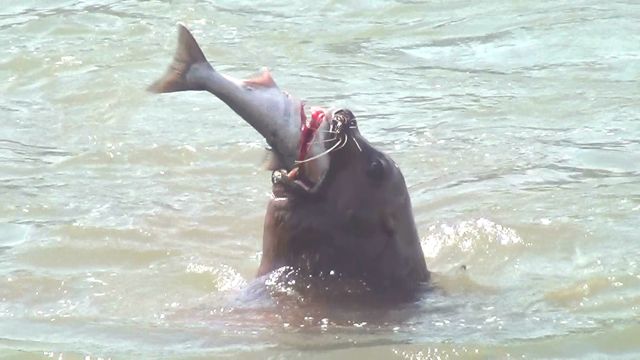forum
library
tutorial
contact

Washington Farmers:
Seals Thwart Salmon Recovery
by Don Jenkins
Capital Press, June 29, 2018
|
the film forum library tutorial contact |

|
Washington Farmers:
by Don Jenkins
|
Save Family Farming argues diminishing agriculture won't revive salmon as long as harbor seals gobble smolts
 A Washington farm advocacy group wants harbor seals in the Salish Sea to get the same notoriety as the California sea lions eating salmon in the Lower Columbia River.
A Washington farm advocacy group wants harbor seals in the Salish Sea to get the same notoriety as the California sea lions eating salmon in the Lower Columbia River.
Harbor seals eat an estimated 23 million young salmon each year in the sea, a network of coastal waterways that include Puget Sound and Strait of Juan de Fuca. The take dwarfs the number of salmon eaten by sea lions near Bonneville Dam. The U.S. House on Tuesday passed over to the Senate a bill to revise the 1972 Marine Mammal Protection Act to let states and tribes euthanize more sea lions in the river.
Save Family Farming says the bill should extend to harbor seals in the Salish Sea. The seals are scuppering salmon recovery, which ratchets up pressure in northwest Washington to downsize agriculture to give fish more habitat and water, according to the group.
"Everyone is getting so pinched to give back habitat, and it's a little hard to understand how habitat is the only problem," said Skagit County farmer Zachary Barborinas. "I think this is one more large factor that has to be considered."
A recent study led by National Ocean and Atmospheric Administration scientists estimated that harbor seals, California sea lions, Steller sea lions and killer whales ate 31.5 million chinook salmon in coastal waters between California and Alaska in 2015, a sixfold increase since 1975. Some 86 percent of those salmon were consumed by the Salish Sea's 77,800 harbor seals, up from 8,600 in 1975.
The consumption of salmon by the protected mammals "could be masking the success of coastwide salmon recovery," according to the study, posted online in November by Scientific Reports.
Save Family Farming director Gerald Baron said the group will wage a social media campaign to publicize how harbor seals are affecting salmon.
"They (the public) hear talk about habitat, in-stream flows and culverts," he said. "Farmers are not saying those things are not important, but we're saying that unless you address the foundational issue, they will be counterproductive."
Baron acknowledged the difficulty of targeting a cute mammal on social media. "That's going to be one of our greatest concerns," he said.
Killer whales eat the most salmon by weight, but harbor seals eat the most individual fish. Harbor seals ate 6.5 percent of the total coastwide smolt production, according to the study.
"There's no doubt there are a lot of salmon that get eaten by predators," the study's co-leader, NOAA research scientist Brandon Chasco, said Thursday.
Researchers didn't project how reducing the number of harbor seals would affect salmon survival. "What we don't know is, if the salmon had not been eaten by harbor seals whether they simply would have been consumed by another predator," Chasco said.
He said it was reasonable to bring up the study in discussing fishing, water and land policies, but the study itself doesn't make recommendations. "I certainly wasn't in it to change policy," Chasco said.
According to the NOAA study, the sea's killer whales, which number about 80, eat 190,000 to 260,000 adult chinook salmon annually. Gov. Jay Inslee signed an executive order in March appointing a task force to study how to increase the killer whale population.
The Columbia River Inter-Tribal Fish Commission estimates that California sea lions ate more than 8,900 salmon near Bonneville Dam in 2016. With NOAA approval, almost 200 sea lions have been euthanized in the river since 2008, the Oregon Department of Fish and Wildlife reports.
The House bill would allow Washington, Idaho, Oregon and six tribal groups to each shoot up to 100 sea lions a year, with NOAA approval. Sens. James Risch, R-Idaho, and Maria Cantwell, D-Wash., have introduced similar legislation in the Senate.
Baron said Save Family Farming will ask Cantwell to extend the bill to harbor seals in the Salish Sea. Cantwell's office did not have a comment Thursday.
Democrats on the House Natural Resources Committee opposed the bill. A report signed by seven Democrats on the committee said killing sea lions does not address "far more significant factors" such as dams, habitat loss, climate change, fishing pressure and pesticides.
Related Pages:
Sea Lions Feasting on Columbia River Steelhead by Brian Neale, KXLY, 3/8/18
Ocean Predators by John Harrison, NW Council, 1/16/18
Related Sites:
Final 2016 Pinniped Report: Sea Lion Salmon Take Astoria To Bonneville Dam Could Be 20 Percent Of Run by Staff, Columbia Basin Bulletin 6/17/16
Evaluatin of Pinniped Predation on Adult Salmonids and Other Fish in the Bonneville Dam Tailrace by Kyle Tidwell, Bjorn van der Leeuw, Lindsay Magill, Brett Carrothers, and Robert Wertheimer, USACOE 5/5/17
learn more on topics covered in the film
see the video
read the script
learn the songs
discussion forum
